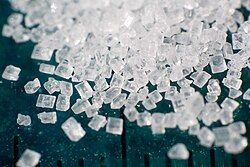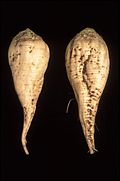Sucrose

Introduction[edit]

Sucrose, commonly known as table sugar, is a disaccharide composed of glucose and fructose molecules. It is widely used as a sweetener in foods and beverages, as well as in the production of various industrial products. Sucrose is an important source of energy for the human body, but excessive consumption can lead to health problems such as obesity, diabetes, and tooth decay.
Chemical Structure[edit]

Sucrose has a chemical formula of C12H22O11 and a molecular weight of 342.3 g/mol. It is composed of one glucose molecule and one fructose molecule linked together by a glycosidic bond between the carbon atoms at positions 1 and 2. Sucrose is a white, crystalline powder that is soluble in water and has a sweet taste.
Sources and Production[edit]
Sucrose is primarily derived from sugarcane and sugar beets, which are processed to extract the juice containing the sugar. The juice is then clarified, evaporated, and crystallized to produce raw sugar. Raw sugar is further refined to produce granulated sugar, which is the form commonly used in households and food production.
Uses[edit]
Sucrose is a widely used sweetener in the food and beverage industry, and is found in a variety of products such as soft drinks, baked goods, candy, and dairy products. It is also used in the production of alcoholic beverages, pharmaceuticals, and industrial products such as paper and textiles.
Health Effects[edit]
Sucrose provides energy for the body, but excessive consumption can lead to health problems such as obesity, diabetes, and tooth decay. The World Health Organization recommends that adults limit their intake of free sugars, including sucrose, to less than 10% of total daily energy intake. Consuming too much sucrose can also lead to fluctuations in blood sugar levels and can increase the risk of developing insulin resistance.
Alternatives[edit]
There are several alternative sweeteners available that can be used in place of sucrose. These include natural sweeteners such as honey, maple syrup, and agave nectar, as well as artificial sweeteners such as aspartame, saccharin, and stevia. These sweeteners provide a sweet taste without the calories or negative health effects associated with sucrose.
Culinary Applications[edit]
Sucrose is a common ingredient in many culinary applications, ranging from sweet desserts to savory dishes. It is often used in baking to provide sweetness and to help baked goods brown and caramelize. In candy making, sucrose is used to make hard candies, caramels, and fudge. It is also used to sweeten beverages such as tea, coffee, and soft drinks.
Industrial Uses[edit]
Sucrose has a variety of industrial applications beyond food production. In the pharmaceutical industry, it is used as a coating for tablets and capsules to improve their taste and appearance. Sucrose is also used as a bulking agent and filler in the production of some medications. In the textile industry, sucrose is used to produce viscose rayon, a type of fabric made from cellulose. Sucrose is also used in the production of ethanol and other biofuels.
Health Benefits[edit]
While excessive consumption of sucrose can lead to negative health effects, small amounts of sucrose can provide some health benefits. Sucrose can help provide energy for physical activity, and small amounts of sugar can help improve mood and cognitive function. Additionally, sucrose can be part of a balanced diet when consumed in moderation as part of a healthy diet that includes a variety of fruits, vegetables, whole grains, and lean protein.
References[edit]
<references />
-
Sucrose
-
Sucrose
-
Sucrose
-
Sucrose
-
Sucrose
-
Sucrose
-
Sucrose
-
Sucrose
-
Sucrose
-
Sucrose
Ad. Transform your life with W8MD's Budget GLP-1 injections from $75


W8MD offers a medical weight loss program to lose weight in Philadelphia. Our physician-supervised medical weight loss provides:
- Weight loss injections in NYC (generic and brand names):
- Zepbound / Mounjaro, Wegovy / Ozempic, Saxenda
- Most insurances accepted or discounted self-pay rates. We will obtain insurance prior authorizations if needed.
- Generic GLP1 weight loss injections from $75 for the starting dose.
- Also offer prescription weight loss medications including Phentermine, Qsymia, Diethylpropion, Contrave etc.
NYC weight loss doctor appointmentsNYC weight loss doctor appointments
Start your NYC weight loss journey today at our NYC medical weight loss and Philadelphia medical weight loss clinics.
- Call 718-946-5500 to lose weight in NYC or for medical weight loss in Philadelphia 215-676-2334.
- Tags:NYC medical weight loss, Philadelphia lose weight Zepbound NYC, Budget GLP1 weight loss injections, Wegovy Philadelphia, Wegovy NYC, Philadelphia medical weight loss, Brookly weight loss and Wegovy NYC
|
WikiMD's Wellness Encyclopedia |
| Let Food Be Thy Medicine Medicine Thy Food - Hippocrates |
Medical Disclaimer: WikiMD is not a substitute for professional medical advice. The information on WikiMD is provided as an information resource only, may be incorrect, outdated or misleading, and is not to be used or relied on for any diagnostic or treatment purposes. Please consult your health care provider before making any healthcare decisions or for guidance about a specific medical condition. WikiMD expressly disclaims responsibility, and shall have no liability, for any damages, loss, injury, or liability whatsoever suffered as a result of your reliance on the information contained in this site. By visiting this site you agree to the foregoing terms and conditions, which may from time to time be changed or supplemented by WikiMD. If you do not agree to the foregoing terms and conditions, you should not enter or use this site. See full disclaimer.
Credits:Most images are courtesy of Wikimedia commons, and templates, categories Wikipedia, licensed under CC BY SA or similar.
Translate this page: - East Asian
中文,
日本,
한국어,
South Asian
हिन्दी,
தமிழ்,
తెలుగు,
Urdu,
ಕನ್ನಡ,
Southeast Asian
Indonesian,
Vietnamese,
Thai,
မြန်မာဘာသာ,
বাংলা
European
español,
Deutsch,
français,
Greek,
português do Brasil,
polski,
română,
русский,
Nederlands,
norsk,
svenska,
suomi,
Italian
Middle Eastern & African
عربى,
Turkish,
Persian,
Hebrew,
Afrikaans,
isiZulu,
Kiswahili,
Other
Bulgarian,
Hungarian,
Czech,
Swedish,
മലയാളം,
मराठी,
ਪੰਜਾਬੀ,
ગુજરાતી,
Portuguese,
Ukrainian









